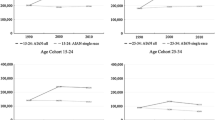Abstract
With the increasing interest in the impact of immigration on the character of the Australia’s population it is useful to draw attention to the differences that can occur when comparisons of the immigrant and the host population with respect to socioeconomic status are based on aggregate rather than on disaggregate measures. In this paper the discussion focuses on the implications of not disaggregating by age and sex, with respect to such variables as: post-school qualifications, occupation, and labour-force participation, using the total overseas-born population in Australia as an example. The analysis demonstrates the fact that the different age structures of the immigrant and the host populations can result in deficiencies in the aggregate rates.
Similar content being viewed by others
References
Australian Bureau of Statistics. Various years. 1986. Census microfiche tables and special tabulations.
Australian Bureau of Statistics. 1989a.Summary Characteristics of Persons and Dwellings. Australia. Census of Population and Housing 30 June 1986. Cat. No. 2487.0. Canberra.
Australian Bureau of Statistics. 1989b.Cross-classified Characteristics of Persons and Dwellings. Australia. Census of Population and Housing 30 June 1986, Cat. No. 2498.0. Canberra.
Australian Bureau of Statistics. 1990.Estimated Resident Population by Country of Birth Age and Sex: Australia, June 1989 and Preliminary June 1990. Cat. No. 3221.0. Canberra (and for earlier years).
Australian Bureau of Statistics. 1991a.The Labour Force Australia June 1991. Cat. No. 6203.0. Canberra.
Australian Bureau of Statistics.1991b.Labour Force Status and Other Characteristics of Migrants, Australia September 1990. Cat. No. 6250.0. Canberra.
Australian Bureau of Statistics, Brisbane. 1990.The Economic Status of Migrants in Australia. Canberra: Bureau of Immigration Research, Australian Government Publishing Service.
Bureau of Immigration Research. Various years.Community Profiles. Canberra: Australian Government Publishing Service (for several birthplace populations).
Department of Employment Education and Training. 1990.Council on Overseas Professional Qualifications. Annual Report 1988–89. Canberra: Australian Government Publishing Service.
Department of Immigration, Local Government and Ethnic Affairs. 1988a.Council on Overseas Professional Qualifications. Annual Report 1986–87. Canberra: Australian Government Publishing Service.
Department of Immigration, Local Government and Ethnic Affairs. 1988b.Australia. Population Trends and Prospects 1988. Canberra: Australian Government Publishing Service.
Gregory, R.G. 1990. Jobs and gender: a Lego approach to the Australian labour market. Canberra: Discussion Paper No. 244, Centre for Economic Policy Research, The Australian National University.
Hogan, R. 1988. A pack of dole bludgers? The distribution and selected characteristics of the New Zealand born population in Australia.New Zealand Population Review 14 (2):19–45.
Hogan, R. 1990. Kiwis in Oz.New Zealand International Review 15(4):14–19.
Kilpatrick, S.J. 1962. Occupational mortality indices.Population Studies 16(2):175–187.
New Zealand Department of Statistics. 1987.1986 New Zealand Census of Population and Dwellings, Age and Marital Status. Series C Report 3, Cat No. 02.004. Wellington.
Price, C.A. 1981.Australian Immigration. A Bibliography and Digest. Number 4 Supplement 1981. Canberra: Department of Demography, Research School of Social Sciences, The Australian National University.
Whiteford, Peter. 1991a.Immigrants and the Social Security System. Canberra: Bureau of Immigration Research, Australian Government Publishing Service.
Whiteford, Peter. 1991b. Are immigrants overrepresented in the Australian Social Security System?Journal of the Australian Population Association 8(2):93–110.
Young, Christabel. 1983. Characteristics and complexities of the migrant labor force in Australia. In Dennis Trewin (ed.),Statistics in the Labor Market. New York: Marcel Dekker, pp. 45–74.
Young, Christabel. 1992. Are there any differences between New Zealand immigrants and the Australian-born population? Socioeconomic and demographic issues. In Gordon Carmichael (ed.),Trans Tasman Migration. Trends, Causes and Consequences. Canberra: Bureau of Immigration Research, Australian Government Publishing Service (forthcoming).
Author information
Authors and Affiliations
Rights and permissions
About this article
Cite this article
Young, C. Pitfalls in comparing immigrants with the Australian-born population with particular reference to socioeconomic status. Journal of Population Research 9, 25–52 (1992). https://doi.org/10.1007/BF03029548
Issue Date:
DOI: https://doi.org/10.1007/BF03029548




